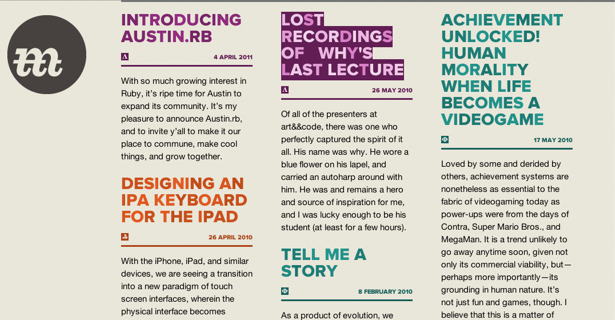 Typography is defined as the style, arrangement, or appearance of typeset matter. A look around your surroundings will reveal how much typography has influenced the world. But does it matter, particularly with the likes of YouTube, Flickr, and other forms of media growing so rapidly?
Typography is defined as the style, arrangement, or appearance of typeset matter. A look around your surroundings will reveal how much typography has influenced the world. But does it matter, particularly with the likes of YouTube, Flickr, and other forms of media growing so rapidly?
It doesn't have depth, color, motion. It doesn't generate feelings or emotions. It provides us with information; line after line of monotonous information. It's text!
The YouTubes, Vimeos, Flickrs, and Instagrams of today's generation feed those who want to forget about typography. They want information with visual and audible cues. As one would expect, gobs of text doesn't exactly inspire them.
But the Web is still young. Things are growing at a rapid pace, much faster than before. We could, in a large part, thank Internet Explorer 6's demise for this progression. Now we have the freedom to run wild, explore our creativity, and make typography something that does more than present information.
Will we take advantage of this rare opportunity?
Time is of the essence
Remember back to a time before there was broadband. Remember how impressive it was to see big blobs of information after clicking on this thing called a "webpage." Sure, there wasn't much in the way of images, sparkly graphics, or video — and also not much in the way of distraction, either — but there was a great sense of appreciation to be had; this is a new world of information, and it's all accessible with the tap of a fingertip. Sure, it might have taken a bit longer than it does today, but when all was said and done, we were all floating on cloud nine.
That was then.
It no longer has the same magical feel that it once had. I know that I take it for granted. Maybe we all do. We expect images, videos, and visual feedback. We want things to gracefully fade in and out. We want to see the subject matter, in as many pixels as our screens will allow. And we want to see video, just in case the point wasn't made clear the first time (bonus points if you include cute kittens).
We expect more than we did back then — rightfully so; this is 2011, and we have the technologies available to us as developers and consumers to enjoy information and new and inspiring ways.
 Beautiful typography stands out throughout Mattt Thompson's personal website.
Beautiful typography stands out throughout Mattt Thompson's personal website.
Designers and developers are producing content for a new age of consumerism. Those consumers don't have all day to sift through information. There is too much of it. We know that. What we spent hours doing a decade ago, they spend mere minutes, if they can even last that long. They want information, and they want it now, and they want it in easily digestible formats that will get them in and out in the fastest way possible. If this means writing something in three pages that normally required three hundred, then so be it. They don't have time to watch 10 minute long YouTube videos — they want it in a single minute.
In the battle for attention, the "TL;DR" is the admission that the battle has been lost. Yes, this ADHD-filled world is going to take its toll on the Web. It's going to get a whole lot worse before it gets any better.
So who has time for text? We have audio and video at our disposal. It can present information much faster than text could. Indeed, whoever said that a picture is worth a thousand words was not lying; people these days prefer it that way.
But what if there was a way to regain their attention using nothing more than typography?
Typography's resurgence
Thanks to a growing number of improvements in Web typography, we might not have to worry about the fate of the written word. Instead of diminishing the value of typography, we are seeing a resurgence in it. Interest in typography, especially from Web designers, has skyrocketed. The tools used to render typographical elements are improving — from enhancements introduced and continually developing with CSS3 to JavaScript tools like Lettering.js and jQuery. It is now feasible to create a webpages that look beautiful by using nothing more than a little vision, creativity, code, and typographical know how.
CSS3 has introduced a fair share of flair for typographers. A number of new properties have enabled them to radically expand their usage of typographical elements: transform, transition, column, text-shadow, rotate, and blur properties are just to name a few. The @font-face property, in particular, has also done plenty for Web designers that services like TypeKit are now solely geared towards supplying Web designers with beautiful, Web-ready fonts, something that wasn't even possible a few years ago.
 Designing Monsters uses CSS3 to create bold, eye-catching typography.
Designing Monsters uses CSS3 to create bold, eye-catching typography.
JavaScript is also contributing to typography's resurgence. Lettering.js, in particular, is one of a few tools that have been produced to aid in the creation of beautiful typography on the Web. A JavaScript library called jQuery, which is arguably one of the most discussed on the Web these days, is also stirring things up. JavaScript doesn't have all of the limitations that CSS3 has, particularly when it comes to the Web browser support; it isn't perfect, but it gives Web designers more abilities to expand their typographical ambitions.
All of this has culminated into a plethora of typographical experiments that look beautiful in native Web browsing environments (if the given browsers support CSS3 and JavaScript); however, many of these impressive experiments lack consistency throughout the browser market. Some experiments result in variances in different browsers, others won't render at all.
Unfortunately, this leads to questions as to whether or not all of CSS3's latest features are ready for the primetime. Sure, Web developers will freely explore their creativity on personal websites; however, exploring these advanced features on a site that receives thousands to millions of hits on a daily basis is risky without planning for the worst case scenarios.
There is plenty of optimism, though. It just might take awhile before we see something like this, this, this, or even this appearing on your everyday webpage.
The future
There are many questions about the Web's future. What impacts will the rise of video have on media consumption. What impact will the drastic increase in media being presented to users have (and will those consuming it be able to manage)? What will the transition to mobile devices bring? How will the open Web compete with application platforms like iOS and Android?
 Naz Hamid utilizes the latest techniques to create a stunning typographical experience.
Naz Hamid utilizes the latest techniques to create a stunning typographical experience.
But the question about whether text/typography will be relevant in the future, that is simple: text is one of the best ways to present information. Web typography will continue to make advances that will ensure that the look of text on the websites will remain fresh and beautiful as ever. Also, the way we perceive text will adapt to these improvements.
Embrace all of the various media formats, but remember that typography is still the most important type of media that exists on the Web today. It was there when it started, it's here now, and it will continue to be for the distant future. So be sure to explore ways to continually maximize its beauty and usefulness.
Written exclusively for WDD by James Mowery. He is a passionate technology journalist and entrepreneur who has written for various top-tier publications like Mashable and CMSWire. Follow him on Twitter: @JMowery.

















